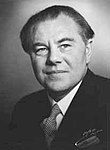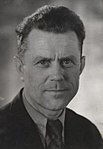From Wikipedia, the free encyclopedia
Danish general election, 1953 Turnout 80.6%
First party
Second party
Third party
Leader
Hans Hedtoft
Erik Eriksen
Ole Bjørn Kraft
Party
Social Democrats
Venstre
Conservatives
Last election
61 seats, 40.4%
33 seats, 22.1%
26 seats, 17.3%
Seats won
74
42
30
Seat change
Popular vote
894,913
499,656
364,960
Percentage
41.3%
23.1%
16.8%
Fourth party
Fifth party
Sixth party
Leader
Jørgen Jørgensen
Aksel Larsen
?
Party
Social Liberals
Communists
Justice
Last election
13 seats, 8.6%
7 seats, 4.8%
9 seats, 5.6%
Seats won
14
8
6
Seat change
Popular vote
169,295
93,824
75,449
Percentage
7.8%
4.3%
3.5%
Seventh party
Leader
?
Party
Schleswig Party
Last election
0 seats, 0.4
Seats won
1
Seat change
Popular vote
9,721
Percentage
0.5%
General elections were held in Denmark on 22 September 1953,[ 1] constitution . The Social Democratic Party remained the largest in the Folketing , with 74 of the 179 seats. Voter turnout was 80.6% in Denmark proper and 68.6% in Greenland .[ 2]
Results
Denmark
Party
Votes
%
Seats
+/–
Social Democratic Party 894,913
41.3
74
+13
Venstre 499,656
23.1
42
+9
Conservative People's Party 364,960
16.8
30
+4
Danish Social Liberal Party 169,295
7.8
14
+1
Communist Party of Denmark 93,824
4.3
8
+1
Justice Party of Denmark 75,449
3.5
6
–3
Independent Party 58,573
2.7
0
New
Schleswig Party 9,721
0.5
1
+1
Invalid/blank votes
5,645
–
–
–
Total 2,172,036 100 175 +26
Source: Nohlen & Stöver
Popular vote
A
41.31%
D
23.06%
C
16.85%
B
7.81%
K
4.33%
E
3.48%
U
2.70%
Others
0.45%
Faroe Islands
Only two candidates ran in the two-seat Faroes constituency, one from the Union Party and one from the Social Democratic Party . Both were re-elected unopposed.[ 2]
Greenland
Party
Votes
%
Seats
Independents
6,183
100
2
Invalid/blank votes
232
–
–
Total 6,415 100 2
Source: Nohlen & Stöver
References




